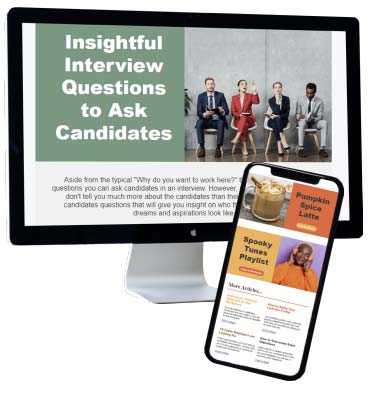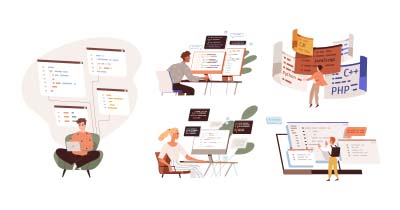Before You Go!
Sign up for our newsletter - which features professional templates, job market updates, articles, playlists, recipes, and more, sent directly to your inbox!



There’s no doubt that the Coronavirus pandemic is changing who we are and what we value. You may have recently discovered new interests, decided to improve your economic state, desired to have more flexible hours, or just felt like you needed to take more control of your life. If you are realizing that your career goals post-pandemic aren’t in line with your current path, it might be time to start transitioning into a new career.
According to a recent Joblist survey, more than 75% of people were found to be happier and more satisfied after making a career change. It may sound like a daunting task at first. However, in the following guide, you will find that you are more than capable of making a successful career change.

Understanding your current skills and strengths is especially important when shifting into a new career, as it will play a large role in understanding how well you will fit into various positions. Evaluating both your hard skills (teachable/technical skills such as writing, math, or your ability to use computer programs) and soft skills (attributes and personality traits such as communication, leadership, or organization) play a key role in this process.
Even if you don’t think you have valuable transferrable skills, you do. We have often found that individuals with backgrounds in hospitality, restaurant management, high-end retail, and luxury car sales have a variety of valuable transferrable skills that often go overlooked or unnoticed. Start by reviewing your past work experience, positions you’ve held, volunteer work, projects, and club involvement to identify your skillset. If you work in hospitality, for example, you may have valuable negotiation and problem-solving skills. Take note of the areas that you excel in as well as those you may be lacking. For more advice on identifying your strengths, read our article, Identifying Your Strengths to Excel in Your Career.
As an example, let’s say Sally is a mother of two with a high school diploma who is a sales associate at a high-end retail store. While sales is her most immediately assumed skill, she may also have experience maintaining productive client relationships, excellent verbal communication, and strong problem-solving skills. Sally is also the president of the PTA at her youngest child’s elementary school, which has given her leadership experience as well as accounting and project-planning skills (as she plans and executes events to raise funds for her child’s school). Being a working mother has also given Sally top-notch organizational and time-management skills.
As you can see, while sales is one skill gained from her luxury retail position, Sally can also identify several other transferrable skills from her volunteer work and personal life experiences.
Once you have a list of your current skills, you can use it to determine the careers you might be interested in moving into. Start by searching for positions that fit your current set of skills and then make a list containing each position. Someone with skills earned from luxury car sales, for example, may find that careers involving sales or leasing may be a good fit. Once you have your list of possible positions, pick a few that stand out enough for you to do some more in-depth research. For each position you’ve considered, ask if you need to go back to school/advance your education for it, complete a certification, or supplement the skills you already have. Knowing these things will help you make your final decision.
Let’s use Sally from our previous example. Say Sally has her list of skills, which include sales, customer relationship management, verbal communication, time-management, and so on. What she’ll do next is try to find positions with requirements that fit those criteria. After some digging, Sally has a list of up to 10 possible positions she could move into, a few of which stand out the most to her: financial services sales agent, customer service representative, or an apartment leasing consultant.
After some additional digging, Sally discovers that she would need to earn a bachelor’s degree to qualify for a Financial Services position. With her two little ones going to school and her leading the PTA, she would have to sacrifice a lot to go back to school herself. However, she notices Customer Service Representatives have a high school-level education requirement. Upon further investigation, though, she discovers that it will be primarily responding to customer complaints, but Sally prefers to help customers find products that fit their interests. When looking into the Leasing Consultant position and how to land a job in property management, Sally sees a lot of cross-over with her skills and interests, so she decides that’s the position she’d like to move into.

After deciding which career you would like to shift into, the next step is to prepare yourself and your expectations. Changing careers is a process. In most cases, when you change your career, you will be starting in an entry-level or temporary position. What this means, is that you will likely experience a drop in income. However, stay positive and remember you chose this career change because of the growth potential and enjoyment you saw in it and in yourself.
Prepare yourself for the change by researching your salary options. While you may most likely start on the ground floor, explore entry to mid-level salary options, as you’ll want to know not just where you’ll start, but where you’ll grow into. Then, set aside income. While it isn’t always necessary to set aside income when changing careers, it may provide you with a safety net that’ll allow you to feel more comfortable during your transition.
In Sally’s case, she decided to set aside some savings to ensure she could provide for her family during her transition. While she did her research and found that she could grow into a position that paid well enough to suite her current lifestyle and more, she decided that she wanted to start with temporary work to test out if the role was the right fit for her and then work her way into a full-time position. Having savings available will allow Sally to comfortably transition.
Creating a career change plan is much like creating a career map. It’s easy to decide an end goal, such as successfully switching careers, but without a plan or a “map” clarifying the steps you need to take to get there, you can be easily thrown off course.
Typically, when formulating a career map, you’d begin with your starting point, identify your end goal, and then move into an actionable plan with steps and smaller goals. In this case, we’ve already walked you through the first two steps, so the next step is to start building your plan.
When developing your career change plan, you’ll want to identify any obstacles that will require more preparation on your end before transitioning. This may include acquiring more education, a certification, or new skills. For example, if you were exploring a career in new home sales, you would need to take courses and pass an exam to obtain a Real Estate License. Once you’ve identified your obstacles, write them down as new goals and formulate the steps you need to take to reach those goals.
For example, Sally noticed that many high-end apartment communities require their leasing consultants to have some experience with leasing and property management software. Having no previous experience in this industry, Sally identified a subset of goals: 1. Gain experience with leasing and 2. Learn how to use property management software. While conducting her research, Sally discovered that temporary and temp-to-hire leasing roles offered on-the-job experience without requiring extensive background in property management. Knowing this, Sally was able to write her first actionable step, which was to apply for temporary and temp-to-hire roles.
When creating your career change plan, make sure to write everything down. Having every goal and obstacle written down will help you stay on track. For more tips on how to create a career map, read our article How to Create a Career Map & Land Your Dream Job.

The last step is the simplest but most important step. Get to working on your goals. Once you have your plan laid out, make sure to hold yourself accountable every step of the way. As we said before, making a career change is a process but if you put in the effort, you will be able to reach your end goal.
Start to train up your transferrable skills. Even if you feel that you’re adequate, become an expert! Take a class or get a certification for your desired career. Even if you won’t need it right away, the certification may come in handy as you move up in your career.
Don’t forget to update your resume to reflect your transferrable skills and abilities, and be sure to include a cover letter to explain your goals and career shift. Start applying for jobs in that desired career field and consider working for a temporary staffing agency. Working temporary positions can give you the opportunity and flexibility to try out that new career while you gain experience in it.
Lastly, read up and get inspired by checking out the Job Seeker & Career Advice section of our website, which is jam packed with resume, interview, and workplace advice!
